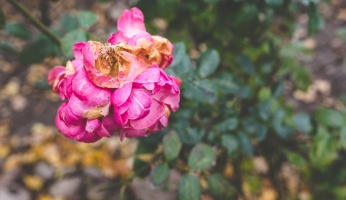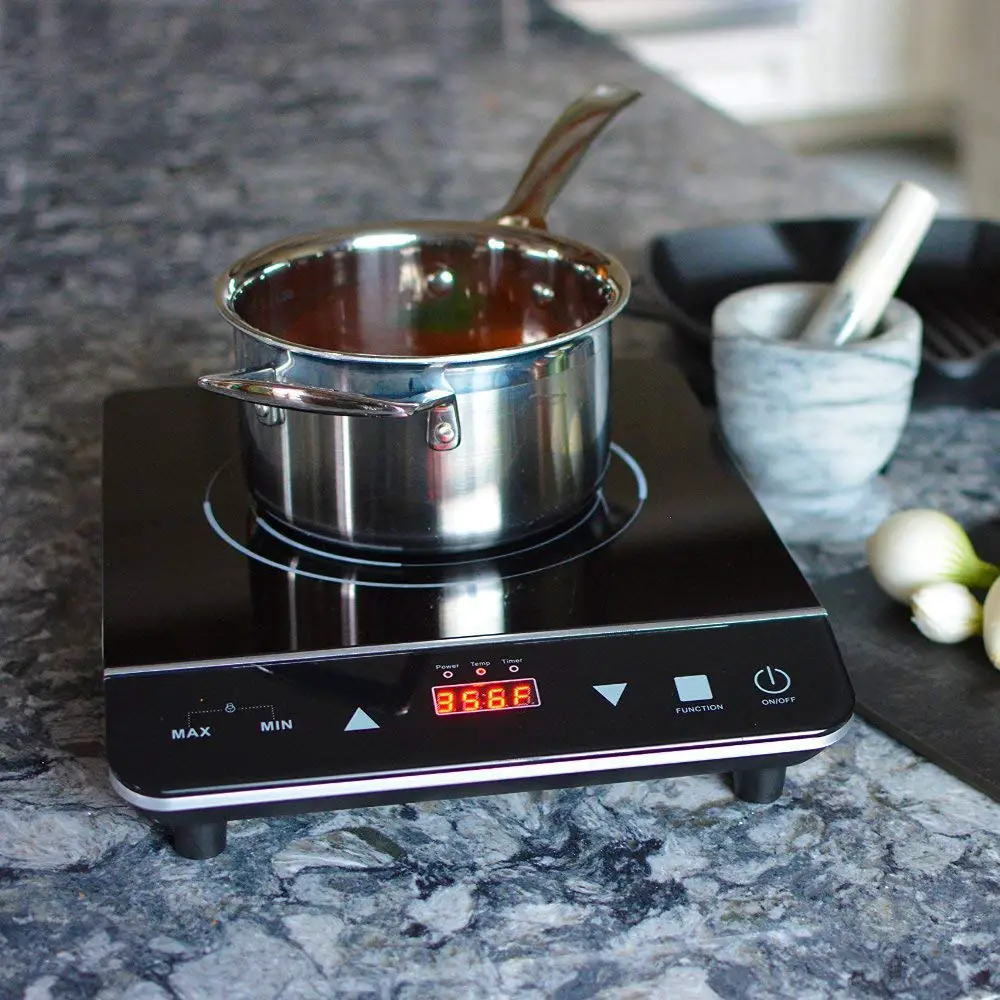38 Best Edible Flowers To Bring Into Your Kitchen
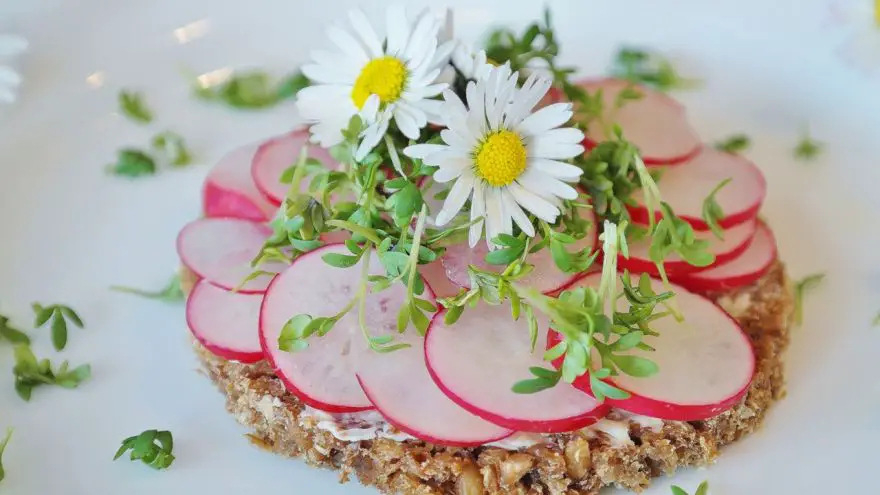 38 Best Edible Flowers To Bring Into Your Kitchen
thegearhunt.com
38 Best Edible Flowers To Bring Into Your Kitchen
thegearhunt.com
Three decades ago, it seemed as if there were flowers everywhere you turned. This was due to the influence of some of the world’s most influential fashion designers, such as Laura Ashley and Donna Martin (responsible for the wardrobe of the TV show Beverly Hills 90210. That being said, the trend towards florals wasn’t simply confined to the fashion world. When it came to haute cuisine with a touch of sophistication, edible flowers became all the rage. You saw things like salads strewn with pansies and violets, and white wine spritzers that were served with ice cubes that contained the frozen petals of flowers. Thankfully, edible flowers (like everything else from the ‘90s, are making a triumphant comeback.
Are you in search of a garnish for desserts, salads, and cakes that is unique? You don’t have to look any further than your own garden. The options include many types beyond the commonly used violets and nasturtiums. However, you do need to be careful with this because some flowers are actually poisonous. It is critical that you accurately identify any flowers you will be serving up as well as making sure that they haven’t been sprayed with any sort of pesticide.
Without any further ado, let’s get to those flowers that you can eat.
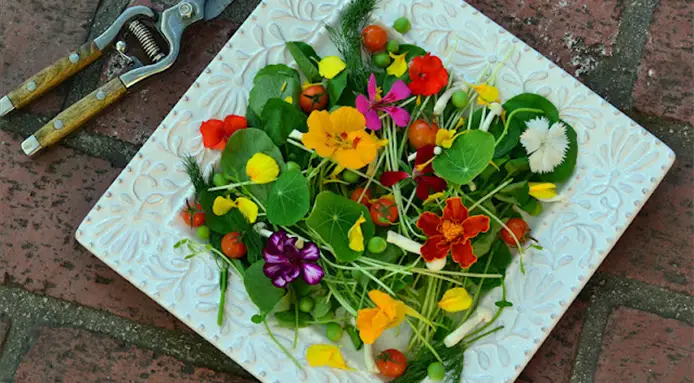 Angelica. This is an herb that features tender stems and lacy white flowers. The taste of this flower is reminiscent of celery. It can be used as a garnish for soup or fish, or in salads.
Angelica. This is an herb that features tender stems and lacy white flowers. The taste of this flower is reminiscent of celery. It can be used as a garnish for soup or fish, or in salads.
Anise Hyssop. You can use the leaves and flowers of this plant if you want to give your food the flavor of anise, or to make it taste slightly like licorice. It is used in Chinese cuisine, as a garnish, or in salads.
Apple. Not the fruit, although that is delicious too. Apple blossoms have a delicate, floral taste that goes well with light spring desserts. This flower should be used in moderation because the blooms may contain the precursors of the cyanide that if found in the seeds.
Arugula. This is also known as the garden rocket. It is commonly seen being used as a green for salads. However, the plant also produces white or yellowish flowers that can give salads a peppery taste.
Basil. This is a commonly found garden herb that produces little clusters of white blooms. Depending on the variety, they may taste of the traditional flavor of basil, chocolate, or mint.
Bee Balm. This is a perennial pat and it produces flowers that form in clusters and look sort of like tubes. These flowers can be dried before being used as a replacement in bergamot tea. Their flavor is mildly citrusy.
Borage. Typically, the flowers on this plant will be blue, but can sometimes be white or pink. The taste is refreshingly reminiscent of cucumbers and it will pair well with fish, salads, and canapes.
Broccoli. When the heads of broccoli mature, they will open up and reveal little yellow flowers. If you pinch these off, it can encourage the broccoli to grow more, but you can also use them in cooked dishes or salads. They have a spicy taste.
Chrysanthemum. You can blanche the petals of this flower before sprinkling them over sauces, soups, and salads for a peppery taste that is a bit spicy. Stay away from the base of the flower though because it can be bitter as well as being difficult to properly digest.
Calendula. There have been times when the dried flowers of this plant have been called ‘poor man’s saffron’. You can use it to add a peppery, spicy taste to food.
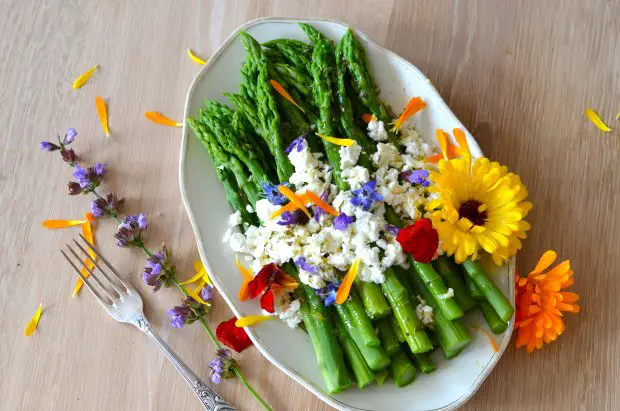 Carnation. Only use these if they are free from pesticides. You can use them in salads if you want a peppery sort of taste. You can also use the entire flower as a garnish on desserts and cakes.
Carnation. Only use these if they are free from pesticides. You can use them in salads if you want a peppery sort of taste. You can also use the entire flower as a garnish on desserts and cakes.
Chamomile. The white or yellow flowers of this plant have been in use for centuries when it comes to herbal teas that are soothing. Only ever use the petals though. Chamomile can produce an allergic reaction in some people.
Chervil. The white flowers of the chervil can be put to use in salads or even in main dishes when you want to give the food a taste of licorice. You will need to add the flowers to the food directly before you serve it though because heating them will dilute the flavor.
Chicory. This plant grows wild in many areas of the US. It has blue blooms which will add a slightly peppery taste to your salads. You should pickle their buds like capers.
Chives. The smallish violet flowers can be added to salads when you want a mild flavor of onions. These flowers will begin to emerge in the middle of spring.
Cilantro. When it comes to this plant, most people just use the leaves. However, the flowers also have a fresh, herbal taste. There are some people who think the taste of cilantro is soapy and they avoid it. Others can’t seem to get enough. This plant is often used in Mexican food.
Cornflower. You may have heard this plant being called bachelor’s button. The flowers are small and shaped like pom poms. They make great garnishes. Typically, the flowers will be blue and taste either spicy or sweet.
Dandelion. You can serve these in salads and it provides a taste that is slightly sweet or peppery. When you cook them in butter, they are reminiscent of mushrooms. Young flowers and buds seem to be favored. This is because the more mature the flower, the more bitter the taste.
Day Lily. These need to be eaten in moderation due to the fact that they can have an effect as a laxative. Stay away from all other types of lilies too, because they can be toxic. Day lilies have a taste that has been compared to beans or lettuce.
Dill. You can use the leaves and flowers of this plant to flavor sauces, soups, and salads. Dill dries well, and the flavor is warm, tangy, and aromatic.
Elderberry. These grow wild in New England, the Midwest, and the Pacific Northwest. However, they are also found being cultivated in many parts of the world. The blossoms of the elderberry are creamy and have a taste and fragrance that are sweet. They can be used as a garnish for desserts, but don’t wash them, because this will take most of the flavor away. Also, the leaves and roots of this plant are quite toxic. The raw berries may also cause people who ingest them to become ill.
Gladiolus. These can be filled with mousse when you want an eye-catching presentation. You can also mix their petals in with salads. Their taste is rather bland though, like that of lettuce.
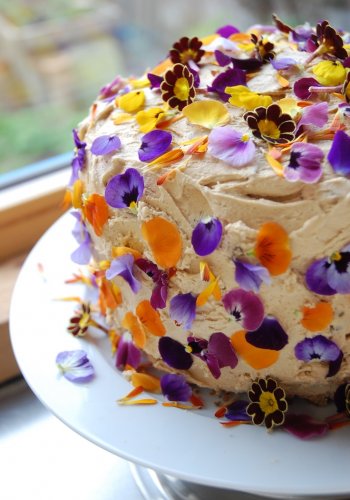 Hibiscus. The taste of the hibiscus flower is tart and a bit bitter. It is typically used when it is dry as a base for an herbal tea. The dried flowers will add a bit of flavor as well as color to your tea.
Hibiscus. The taste of the hibiscus flower is tart and a bit bitter. It is typically used when it is dry as a base for an herbal tea. The dried flowers will add a bit of flavor as well as color to your tea.
Hollyhock. These make garnishes that are quite charming, but the flowers have little texture or taste. Mainly they are used as a decoration.
Honeysuckle. You might remember sucking the sweet nectar from these gold and white flowers when you were a child. The taste is sweet, but you need to avoid the poisonous berries.
Jasmine. You can flavor teas with jasmine, but you need to make sure it is true jasmine as opposed to false jasmine. True jasmine has a sweet scent. False jasmine is also known as Carolina jasmine, trumpet flower, Jessamine, yellow jasmine, or woodbine. All of these are toxic. True jasmine has white, waxy flowers and leaves that are shiny and oval.
Impatiens. This is an annual flower that is fragile. The flavor is sweet, and they are good for use in desserts and drinks. If you want a splash of color, you can add them to your punch bowl or even freeze them in cubes of ice.
Lavender. This is often used in foods that are baked, but they can also be used when they are fresh if you want a light floral or citrus taste to add to desserts or champagne. Don’t use the oil before first making sure that it is safe for use in foods.
Lemon flowers. These fragrant, waxy flowers can be used as garnishes but should only be eaten sparingly. You can also use the leaves (if they haven’t been treated with pesticides) as the base for desserts, roasted meats, and canapes.
Lemon verbena. This is a woody sort of herb that features leaves that give off a strong scent of citrus. You can use the creamy, small flowers when you want to add a bit of citrus flavor to desserts, sauces, lemonades, or teas.
Lilac. The taste of this flower will vary depending on which type it is. Most of them are lemony and slightly bitter. They are frequently used as a decoration for desserts.
Marigold. If you want to add a bit of a peppery flavor and some bright color to a salad, this is how you do it. They are also quite easy to grow.
Marjoram. This flavorful herb features white, small flowers that can be used just as the leaves are. They have a mild taste that can be used both in sauces and in salads.
Mint. Depending on the variety of the mint plant, it can have a mint taste with an undertone of apple, lemon, or chocolate. Mint can be used in Greek salads, lemonade, or tea.
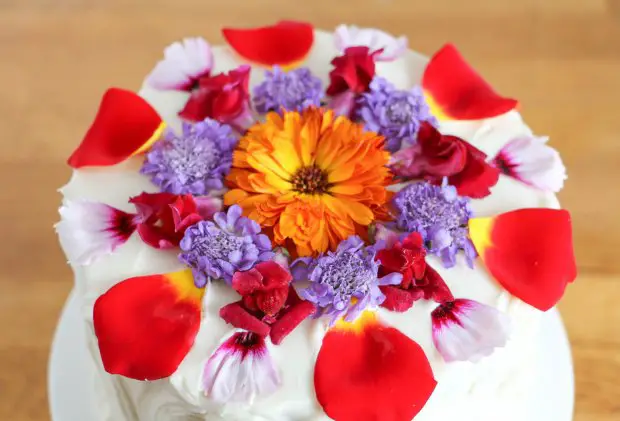 Okra. This thorny vegetable is odd looking, but it produces flowers that are akin to hibiscus. They can be fried or sautéed for an almost exotic treat.
Okra. This thorny vegetable is odd looking, but it produces flowers that are akin to hibiscus. They can be fried or sautéed for an almost exotic treat.
Orange flowers. These can be used just like the lemon flowers are. Use them as a garnish and sparingly. You can also flavor water simply by soaking the blooms in it.
Oregano. The small white flowers of oregano have a taste that is much milder than its leaves. They can be used for meat, in salads or Italian dishes.
Pea Blossom. English peas, snow peas, and snap peas all produce blossoms that are white or pink. These blossoms are tender, sweet, and delicious when used in salads. However, eating their blossoms can decrease your harvest of peas.
A Brief History
Flowers have been in use in kitchens all the way back to the ancient Romans, Greeks, and Chinese. Many cultures have used flowers in their traditional cooking. Adding a few flowers to your foods can be a great way to add a bit of whimsy, flavor, and color. Some of them are fragrant and floral, herbaceous, and even spicy. The flavor range of flowers might surprise you.
It isn’t uncommon to see the petals of flowers being used as a garnish for desserts or in teas and salads. However, they are also the inspiration for a few creative uses. You can roll spicy flowers such as the blossoms from chives in your homemade pasta dough. You might use a few floral ones to add a bit of unique flavor to your handmade ice cream. You can pickle different flower buds, such as nasturtium, like capers. You can even use flowers to make simple syrups for use in cocktails or lemonades. You can even stuff the flowers to make different dishes that will be as aesthetically pleasing as well as pleasing to the palette.
Be Safe with Them
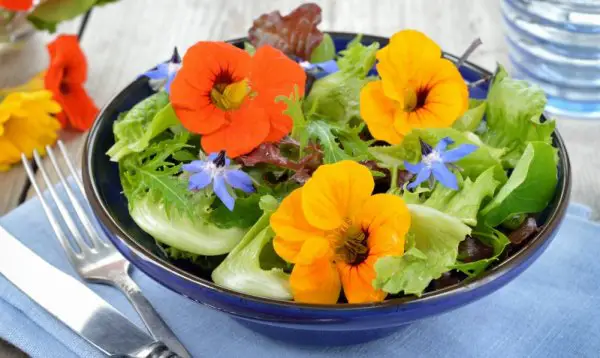 As fantastic as being able to eat flowers is, it also has the chance of being deadly. This isn’t meant to scare you off from trying them, you just need to follow a few tips.
As fantastic as being able to eat flowers is, it also has the chance of being deadly. This isn’t meant to scare you off from trying them, you just need to follow a few tips.
- Only eat flowers that you know for sure are consumable. If you aren’t sure, check a reference book on the subject.
- Only ever eat flowers that you have grown in your garden or that have been grown in the garden of whoever prepared them. Flowers that come from nurseries or florists may have been treated with chemicals or pesticides.
- Never eat flowers found by the side of a road or those that you pick in public area. Both might have been treated with herbicides or pesticides, and the ones near roads can even have been polluted by the exhaust from vehicles.
- Only ever eat the petals of the flowers. Be sure that you always remove the stamens and pistils before they are consumed.
- If you are a sufferer of allergies, you should introduce new flowers to your diet in stages, due to the fact that they can exacerbate your allergies.
- If you want to keep the flowers fresh, put them on a damp paper towel before refrigerating them in a container that is airtight. Doing this can make some of them last for as long as 10 days. If they get limp, icy water may revitalize them.
Adding flowers to your foods can make them look and taste better. They are also a way to liven up the cuisine at any dinner party.
Sources
- Sustainable Baby Steps, Daisies for Lunch: An Edible Flowers List
- The Homestead Garden, The Best Edible Flowers for Your Vegetable Garden
- The Old Farmer’s Almanac, Best Edible Flowers for Growing and Eating
- Oregon Live, 10 of the Best Edible Flowers to Grow in Your Yard






